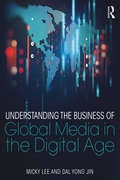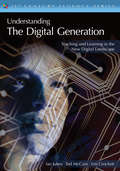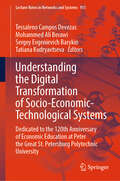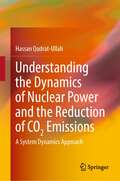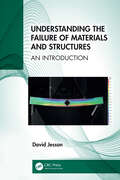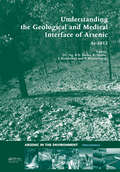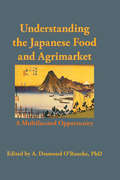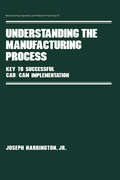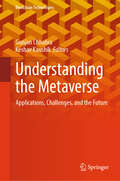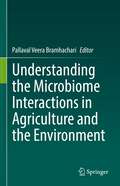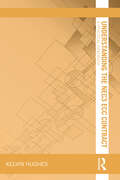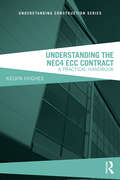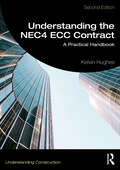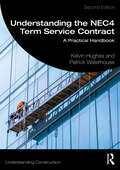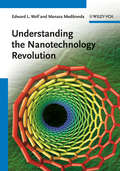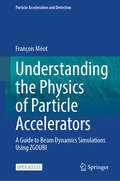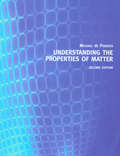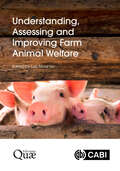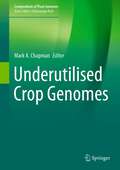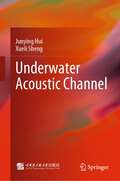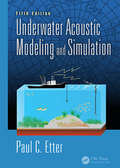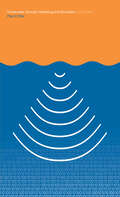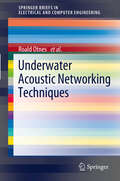- Table View
- List View
Understanding the Business of Global Media in the Digital Age
by Dal Yong Jin Micky LeeThis new introductory textbook provides students with the tools they need to understand the way digital technologies have transformed the global media business of the 21st century. Focusing on three main approaches – media economics, critical political economy, and production studies – the authors provide an empirically rich analysis of ownership, organizational structures and culture, business strategies, markets, networks of strategic alliances, and state policies as they relate to global media. Examples throughout involve both traditional and digital media and are taken from different regions and countries to illustrate how the media business is influenced by interconnected historical, political, economic, and social factors. In addition to introducing today’s convergent world of global media, the book gives readers a greater understanding of their own potential roles within the global media industries.
Understanding the Digital Generation: Teaching and Learning in the New Digital Landscape
by Ian Jukes Lee Crockett Ted McCainAn innovative look at reshaping the educational experiences of 21st-century learners! Inspiring thoughtful discussion that leads to change, this reader-friendly resource examines how the new digital landscape is transforming teaching and learning in an environment of standards, accountability, and high-stakes testing and why informed leadership is so critical. The authors present powerful strategies and compelling viewpoints, underscore the necessity of developing relevant classroom experiences, and discuss: Attributes common among digital learners; The concepts of neuroplasticity and the hyperlinked mind; An educational approach that supports traditional literacy skills alongside 21st-century fluencies; Evaluation methods that encompass how digital generation students process new information.
Understanding the Digital Transformation of Socio-Economic-Technological Systems: Dedicated to the 120th Anniversary of Economic Education at Peter the Great St. Petersburg Polytechnic University (Lecture Notes in Networks and Systems #951)
by Tatiana Kudryavtseva Mohammed Ali Berawi Tessaleno Campos Devezas Sergey Evgenievich BarykinThis book is dedicated to the 120th anniversary of economic education at Peter the Great St. Petersburg Polytechnic University (SPbPU). It gathers the best and most recent research materials of scientists from SPbPU’s Institute of Industrial Management, Economics and Trade and their colleagues from other universities.This book reflects many years of experience, unique results and interesting discoveries made by collaborative teams exploring the following issues: engineering economics, sustainable development and other topics related to the digitalization of enterprises, industries and systems; digital transformation of the service market in the face of global challenges; automation of enterprise control systems, digital and data management solutions for business; socio-economic development and territorial management in the era of Industry 4.0, etc. This book offers various views on challenges faced by today's economy and industry that are undoubtedly relevant to readers of almost all categories: from students to practitioners and scientists, but mostly for researchers.
Understanding the Dynamics of Nuclear Power and the Reduction of CO2 Emissions: A System Dynamics Approach
by Hassan Qudrat-UllahThis books explains a strategy that a country can meet its CO2 emission reduction targets (e.g., as are in Paris Agreement) with a dominant share of nuclear power with a balanced energy supply mix. The book starts with an introduction to the subject of energy policy, mechanisms, and CO2 emissions, and the complexity of the CO2 reduction goal. It introduces the system dynamics approach as a solution modeling approach for dealing with the complexity of CO2 reducing policies and mechanisms. The book presents the dynamic model and its key parameters and then elaborates the structural and behavioral validity of the dynamic model. The book gives an intensive review to do that comparative analysis involving China, India, Saudi Arabia, UAE, and Pakistan. The last half of the book focuses on the case in Pakistan. The author reviews Pakistan’s Intended Nationally Determined Contribution and other key sources from Pakistan’s Ministry of Energy and related institutions. Using Pakistan’s case data, the author applies the system dynamics modeling approach whereby a dynamic model, capable of representing the important interactions among various sectors of the electricity supply sector of Pakistan. This book is intended to be of use to policymakers, managers and practitioners, teachers, researchers, and students of design and assessment of policymaking for the complex, dynamic energy systems
Understanding the Failure of Materials and Structures: An Introduction
by David JessonUnderstanding the Failure of Materials and Structures introduces practical aspects of mechanical characterisation of materials and structures. It gives those with little or no prior experience insight into the process of developing everyday products, issues behind some high-profile failures, and tools to begin planning a programme of research.Written in an easily accessible manner, the work discusses fundamentals of the physical world, highlighting the range of materials used and varied applications, and offers a brief history of materials development. It covers the role of materials structure in controlling materials properties and describes mechanical properties, such as stress, strain, stiffness, fracture, and fatigue. The book also features information on various modes of testing and strain measurement. It provides some discussion on topics that go beyond well-behaved test coupons, with thoughts on biomechanics, megastructures, and testing for applications in extreme environments. Finally, it covers how materials fail and the future of physical testing.With minimal theory and mathematics, this work presents the fundamentals of mechanical characterisation of materials and structures in a manner accessible to the novice materials investigator and the layperson interested in the science behind materials engineered for use in common and advanced products.
Understanding the Geological and Medical Interface of Arsenic - As 2012: Proceedings of the 4th International Congress on Arsenic in the Environment, 22-27 July 2012, Cairns, Australia (Arsenic in the Environment - Proceedings)
by Jochen Bundschuh Prosun Bhattacharya Ravi Naidu Jack C. Ng Barry N. NollerThe congress "Arsenic in the Environment" offers an international, multi- and interdisciplinary discussion platform for arsenic research aimed at practical solutions of problems with considerable social impact, as well as focusing on cutting edge and breakthrough research in physical, chemical, toxicological, medical and other specific issues on ar
Understanding the Impact of Human Interventions on the Hydrology of Nile Basin Headwaters, the Case of Upper Tekeze Catchments (IHE Delft PhD Thesis Series)
by Tesfay Gebretsadkan GebremicaelThe availability and distribution of water resources in catchments are influenced by various natural and anthropogenic factors. Human-induced environmental changes are key factors controlling the hydrological flows of semi-arid catchments. Land degradation, water scarcity and inefficient utilization of available water resources continue to be important constraints for socio-economic development in the headwater catchments of the Nile river basin in particular over the Ethiopian Catchments. This research investigates the impact of landscape anthropogenic changes on the hydrological processes in the Upper Tekeze basin (A tributary of the Nile). The hydrology of the basin is investigated through analysis of hydro-climatic data, remote sensing techniques, new field measurements and parsimonious hydrological models. The empirical evidence provided in this book confirms that human-induced environmental changes can significantly change the hydrology of catchments, both in negative (degradation) and in positive (restoration) ways. This book also shows that rainfall-runoff relationships in semi-arid catchments are non-uniform and hence the application of hydrological models in such catchments need special attention. Moreover, parsimonious dynamic hydrological model improves our understanding of the hydrological response to dynamic environmental changes.
Understanding the Japanese Food and Agrimarket: A Multifaceted Opportunity
by Andrew D O'RourkeThe contributing authors of Understanding the Japanese Food and Agrimarket discuss broad forces that affect markets in Japan and specific situations faced in marketing grain, livestock, and seafood products; fruits; vegetables; and wood products. Many of the contributors speak and read Japanese and have lived in Japan for extensive periods; they are able to give deep insights into how and why the Japanese consumption and distribution system behaves as it does. They draw on their expertise to fully explore various Japanese food and fiber markets. As they demystify the Japanese market, they illustrate for readers several systematic approaches to mastering the Japanese food and fiber markets.Readers will discover that effective long-term marketing strategies in Japan must be based on sound analytical information. The contributors provide such needed material with chapters on items as diverse as wine, grain products, beef, and fruits and vegetables. Some of the specific topics covered include:changes in Japanese food consumptionJapanese food distribution systemdemand for beef products in Japandemand for vegetables and vegetable seedsJapanese wine marketdemand for bakery productsnew food products for the Japanese marketdeveloping trade relations in wood productsExecutives of commodity associations or firms exporting foods to Japan will find the general sections most interesting as well as chapters specific to their products. Teachers and students exploring exporting to the Japanese market will be intrigued by the various dimensions of the “multifaceted” nature and opportunities of the Japanese market.
Understanding the Manufacturing Process: Key to Successful Cad/cam Implementation
by Joseph Harrington Jr.This book approaches manufacturing as a basic problem of making a desired end-product from bulk raw materials. It encompasses the entire gamut of activities from product concept to maintenance of past products in the field, and everything in between.
Understanding the Metaverse: Applications, Challenges, and the Future (Blockchain Technologies)
by Keshav Kaushik Gunjan ChhabraThis book highlights the numerous potentials and concerns involved with using the metaverse. Furthermore, the project discusses countermeasures to protect any firm from these risks. Insights into practical solutions may assist organizations in using this new business model by raising awareness and preparing them to improve. The book helps readers get insights into technology's future, i.e., the metaverse. The application areas of the metaverse is quite vast, but it also includes security and privacy issues. Addressing the security issues is the need of the hour. Developers are designing the applications, and users are ready to use them, but on the other side, many security issues need to be focused on. Hence, along with the applications, this book helps the reader understand these hidden security and privacy issues.
Understanding the Microbiome Interactions in Agriculture and the Environment
by Pallaval Veera BramhachariThis book illustrates the importance of microbiome interactions in sustainable agriculture and the environment. The chapters of the book provide information pertaining to the vast diversity of microbiomes in many ecosystems and their functional dynamics. The book also discusses bioremediation, space microbiomes, geo microbiomes, coral microbiomes, antibiotic resistomes, and rhizomicrobiome. It also sheds light on the complex syntrophic and other symbiotic interactions between bacteria, protists, plants, and certain animals in agricultural and environmental systems. The book, in turn, provides an understanding of the adaptation, resilience, and evolution of microbial ecosystems. Further, the chapters cover metagenomics analysis of microbiomes of a novel or extreme environments, microbial resilience or temporal fluctuations, symbiosis and co-evolution of the microbiome, and novel microbial interactions in agriculture and environment. Finally, the book elucidates a comprehensive yet representative description of complex structural and functional diversity within the plant and environmental microbiomes to reveal their immense potential. This book covers United Nations Sustainable Developmental Goal 2 towards Zero Hunger.
Understanding the NEC3 ECC Contract: A Practical Handbook (Understanding Construction)
by Kelvin HughesAs usage of the NEC (formerly the New Engineering Contract) family of contracts continues to grow worldwide, so does the importance of understanding its clauses and nuances to everyone working in the built environment. Currently in its third edition, this set of contracts is different to others in concept as well as format, so users may well find themselves needing a helping hand along the way. Understanding the NEC3 ECC Contract uses plain English to lead the reader through the NEC3 Engineering and Construction Contract’s key features, including: main and secondary options the use of early warnings programme provisions payment compensation events preparing and assessing tenders. Common problems experienced when using the Engineering and Construction Contract are signalled to the reader throughout, and the correct way of reading each clause explained. The way the contract effects procurement processes, dispute resolution, project management, and risk management are all addressed in order to direct the user to best practice. Written for construction professionals, by a practicing international construction contract consultant, this handbook is the most straightforward, balanced and practical guide to the NEC3 ECC available. An ideal companion for employers, contractors, project managers, supervisors, engineers, architects, quantity surveyors, subcontractors, and anyone else interested in working successfully with the NEC3 ECC.
Understanding the NEC4 ECC Contract: A Practical Handbook (Understanding Construction)
by Kelvin HughesAs usage of the NEC family of contracts continues to grow worldwide, so does the importance of understanding its clauses and nuances to everyone working in the built environment. Understanding the NEC4 ECC Contract uses plain English to lead the reader through the NEC4 Engineering and Construction Contract’s key features. Chapters cover: The Contractor’s main responsibilities the use of early warnings Contractor’s design Tendering Quality management Payment Liabilities and insurance Termination Avoiding and resolving disputes and much more. Common problems experienced when using the Engineering and Construction Contract are signaled to the reader throughout, and the correct way of reading each clause explained. The way the contract effects procurement processes, dispute resolution, project management, and risk management are all addressed in order to direct the user to best practice. Written for construction professionals, by a practicing international construction contract consultant, this handbook is the most straightforward, balanced and practical guide to the NEC4 ECC available. An ideal companion for employers, contractors, project managers, supervisors, engineers, architects, quantity surveyors, subcontractors, and anyone else interested in working successfully with the NEC4 ECC.
Understanding the NEC4 ECC Contract: A Practical Handbook (Understanding Construction)
by Kelvin HughesAs usage of the NEC family of contracts continues to grow worldwide, so does the importance of understanding its clauses and nuances to everyone working in the built environment. This second edition of Understanding the NEC4 ECC Contract uses plain English to lead the reader through the NEC4 Engineering and Construction Contract’s key features. Chapters cover: Contractor’s main responsibilities The use of early warnings Contractor’s design Tendering Quality management Payment Liabilities and insurance Termination Avoiding and resolving disputes and much more.Common problems experienced when using the Engineering and Construction Contract (ECC) are signalled to the reader throughout, and the correct way of reading each clause explained. The way the contract effects procurement processes, dispute resolution, project management and risk management are all addressed in order to direct the user to best practice. This second edition takes into account the updates to the contract released in 2019, 2020 and 2023, and brings the book up to date with the most current practice.Written for construction professionals, by a practicing international construction contract consultant, this handbook is the most straightforward, balanced and practical guide to the NEC4 ECC available. An ideal companion for employers, contractors, project managers, supervisors, engineers, architects, quantity surveyors, subcontractors and anyone else interested in working successfully with the NEC4 ECC.
Understanding the NEC4 ECC Contract: A Practical Handbook (Understanding Construction)
by Kelvin HughesAs usage of the NEC family of contracts continues to grow worldwide, so does the importance of understanding its clauses and nuances to everyone working in the built environment. This second edition of Understanding the NEC4 ECC Contract uses plain English to lead the reader through the NEC4 Engineering and Construction Contract’s key features. Chapters cover: Contractor’s main responsibilities The use of early warnings Contractor’s design Quality management Payment Liabilities and insurance Termination Avoiding and resolving disputes Tendering Common problems experienced when using the Engineering and Construction Contract (ECC) are signalled to the reader throughout, and the correct way of reading each clause explained. The way the contract effects procurement processes, dispute resolution, project management and risk management are all addressed in order to direct the user to best practice. This second edition takes into account the updates to the contract released in 2019, 2020 and 2023, and brings the book up to date with the most current practice.Written for construction professionals, by a practising international construction contract consultant, this handbook is the most straightforward, balanced and practical guide to the NEC4 ECC available. An ideal companion for employers, contractors, project managers, supervisors, engineers, architects, quantity surveyors, subcontractors and anyone else interested in working successfully with the NEC4 ECC.
Understanding the NEC4 Term Service Contract: A Practical Handbook (Understanding Construction)
by Kelvin Hughes Patrick WaterhouseUse of the NEC4 suite of contracts continues to grow and the new edition of Understanding the NEC4 Term Service Contract includes significant additional materials and changes since its original publication immediately after the initial release of the NEC4 contracts. Experienced authors and construction contracts specialists Kelvin Hughes and Patrick Waterhouse have added numerous practical experiences, case studies, lessons learned and guidance notes which were not available at the time of writing the original book.Covering all the recent updates to the contract and written in plain English, Understanding the NEC4 Term Service Contract offers a practical guide to the use and management of the NEC4 Term Service Contract (TSC). The authors describe the full life of a contract, from the initial selection of options and contract formation through to the operations period and ultimately termination and dispute resolution. Although born of the same stable as the NEC4 construction contracts, the TSC is aimed at maintaining infrastructure and differs significantly from its siblings.This is essential reading for anyone working with the contracts and takes the reader through the important provisions including communications, planning, early warnings, compensation events and payments. It is ideal for clients, contractors and their advisors describing how to deploy the contract successfully.
Understanding the Nanotechnology Revolution
by Edward L. Wolf Manasa MedikondaA unique introduction for general readers to the underlying concepts of nanotechnology, covering a wide spectrum ranging from biology to quantum computing. The material is presented in the simplest possible way, including a few mathematical equations, but not mathematical derivations. It also outlines as simply as possible the major contributions to modern technology of physics-based nanophysical devices, such as the atomic clock, global positioning systems, and magnetic resonance imaging. As a result, readers are able to establish a connection between nanotechnology and day-to-day applications, as well as with advances in information technology based on fast computers, the internet, dense data storage, Google searches, and new concepts for renewable energy harvesting. Also of interest to professionals working in law, finance, or teaching who wish to understand nanotechnology in a broad context, and as general reading for electrical, chemical and computer engineers, materials scientists, applied physicists and mathematicians, as well as for students of these disciplines.
Understanding the Physics of Particle Accelerators: A Guide to Beam Dynamics Simulations Using ZGOUBI (Particle Acceleration and Detection)
by François MéotThis open access book introduces readers to the physics of particle accelerators, by means of beam dynamics simulations and exercises using the computer code ZGOUBI. The respective chapters are organized chronologically and trace the historical development of accelerators from electrostatic columns to storage rings, to the numerous variations on resonant acceleration and focusing techniques, while also addressing side aspects such as synchrotron radiation and spin dynamics. The book offers computer simulations in which readers can manipulate, guide, and accelerate charged particles and particle beams in most types of particle accelerator. By performing these simulation exercises, they will acquire a deeper understanding of charged particle beam optics, accelerator physics and technology, as well as the why and how of when to use one technology or the other. These exercises guide readers through a virtual world of accelerator and beam simulations, and involve e.g. manipulating beams for cancer therapy, producing synchrotron radiation for condensed matter research, accelerating polarized ion beams for nuclear physics research, etc. In addition to acquiring an enhanced grasp of physics, readers will discover the basic theoretical and practical aspects of particle accelerators’ main components: guiding and focusing magnets, radio-wave accelerating cavities, wigglers, etc.
Understanding the Properties of Matter
by Michael de PodestaUnderstanding the Properties of Matter: 2nd Edition takes a unique phenomenological approach to the presentation of matter, materials, and solid-state physics. After an overview of basic ideas and a reminder of the importance of measurement, the author considers in turn gases, solids, liquids, and phase changes. For each topic, the focus is on "what happens." After a preliminary examination of data on the properties of matter, the author raises, then addresses a series of questions concerning the data. It is only in answering these questions that he adopts the theoretical approach to the properties of matter. This approach can reawaken in readers the fascination for the subject that inspired some of the greatest physicists of our age. Examples and extensive exercises reinforce the concepts. A supporting Web site furnishes for free download a plethora of additional materials, including:" Supplementary chapters on the band theory of solids and the magnetic properties of solids" Copies of all the data talbes used in the book, in PDF and spreadsheet formats" Enlarged copies of all figures" A simple molecular dynamics simulation" Animations uillustrating important featrues of key equations" Answers to the end-of-chapter exercisesUnderstanding the Properties of Matter is an entertaining and innovative text accessible at the undergraduate level.
Understanding, Assessing and Improving Farm Animal Welfare
by Luc MounierImproving welfare in farmed animals is good for productivity, consumer demand and, of course, the animals themselves. Covering the current scientific knowledge on the sensitivity and consciousness of animals, this translation of the Le Bien-être des animaux d'élevage series reviews how to understand, assess and then improve farm animal welfare. Beginning with the philosophical and legal history of the consideration of their well-being, it synthesizes this information to build a common reference so that we all share the same notion of what animal welfare actually is. It then evaluates the welfare assessment process, which must be as reliable and objective as possible and require the use of appropriate indicators. Fully outlined in reference documents, these are summarized at the level of specific farming situations for easy reference. Concluding with the different ways of improving animal welfare, the book takes a holistic approach, considering the animals' physical and social environment, the integrated management of their health, the relationship between human and animal, the management of animal suffering, and treatment of animals during transportation and slaughter. Suitable for students and researchers of animal agriculture, animal science and veterinary medicine, this book provides an approachable and comprehensive coverage of this important topic.
Underutilised Crop Genomes (Compendium of Plant Genomes)
by Mark A. ChapmanThis book highlights the uses for underutilized crops, presenting the state-of-the-art in terms of genome sequencing for over 30 crops, previously understudied and under-researched. In a changing climate and with significant pressure on the land, it is the ideal time to be discussing novel crops, with significant biotic and abiotic tolerances and/or rich nutrient profiles for consumers. Previously, the only species with sequenced genomes were high-profile internationally recognized crops, but in the current era genomes are being sequenced for dozens of crops, including those previously classified as underutilized, now being investigated. This book covers food crops, from fruits to tubers, and from grasses to legumes, as well as crops with non-food applications. Some of these crops have draft genomes, and others have polished genomes with extensive resequencing panels. Each chapter tells the story of an individual crop or crop group, written by experts, focusing on the genome data available, revealing more about crop domestication and genetic variation, and the current and future prospects given that this data is now becoming available. It also highlights how even small sequencing projects can provide draft genome sequences suitable for gene discovery, comparative genomics, and identification of molecular markers for understanding these crops further.
Underwater Acoustic Channel
by Junying Hui Xueli ShengThis book introduces sonar system and acoustic channel model, average energy channel, coherent multipath channel, the theoretical basis for the stochastic time-varying space-variant channel, slowly time-varying coherent multipath channel, and reverberation channel. Based on the basic theory of underwater acoustic channels and the various characteristics of the marine acoustic environment factor, this textbook aims to help students understand the impact of the marine acoustic channel on the sonar system. It helps students to grasp underwater acoustic signal processing principles and obtain the ability to solve practical problems in underwater acoustic channel engineering. Finally, it aims at laying a foundation for the further sonar system design. This textbook is recommended for graduate or undergraduate students in the field of sonar signal processing, underwater acoustic engineering, as well as some related subjects of marine technology.
Underwater Acoustic Modeling and Simulation
by Bernt S. AadnoyThis newest edition adds new material to all chapters, especially in mathematical propagation models and special applications and inverse techniques. It has updated environmental-acoustic data in companion tables and core summary tables with the latest underwater acoustic propagation, noise, reverberation, and sonar performance models. Additionally
Underwater Acoustic Modelling and Simulation
by P.C. EtterUnderwater Acoustic Modeling and Simulation examines the translation of our physical understanding of sound in the sea into mathematical models that can simulate acoustic propagation, noise and reverberation in the ocean. These models are used in a variety of research and operational applications to predict and diagnose the performance of complex s
Underwater Acoustic Networking Techniques
by Michele Zorzi Michael Goetz Paul Van Walree Roald Otnes Ivor Nissen Knut Rimstad Thor Husøy Alfred Asterjadhi Paolo CasariThis literature study presents an overview of underwater acoustic networking. It provides a background and describes the state of the art of all networking facets that are relevant for underwater applications. This report serves both as an introduction to the subject and as a summary of existing protocols, providing support and inspiration for the development of network architectures.
